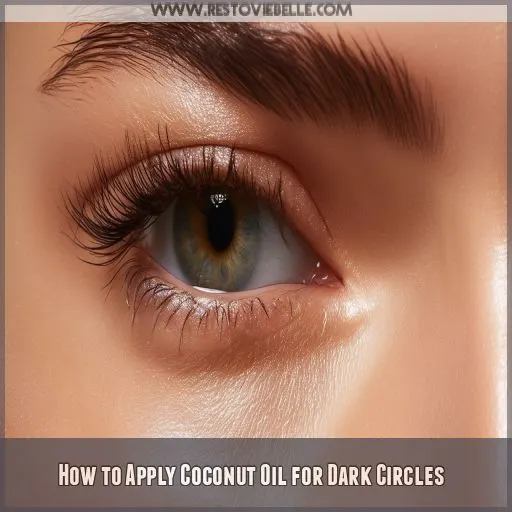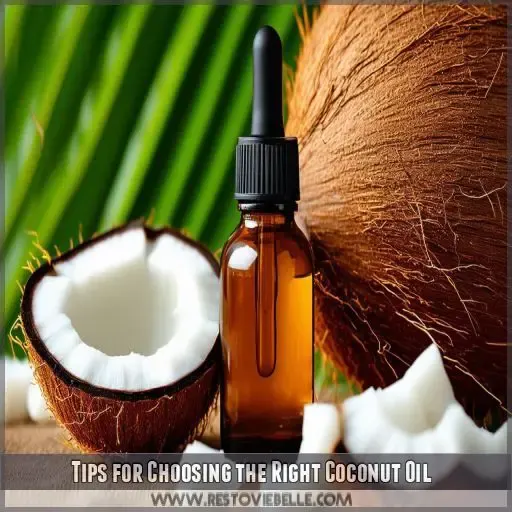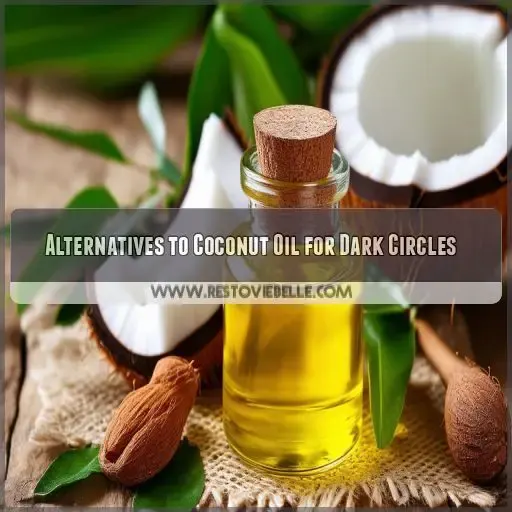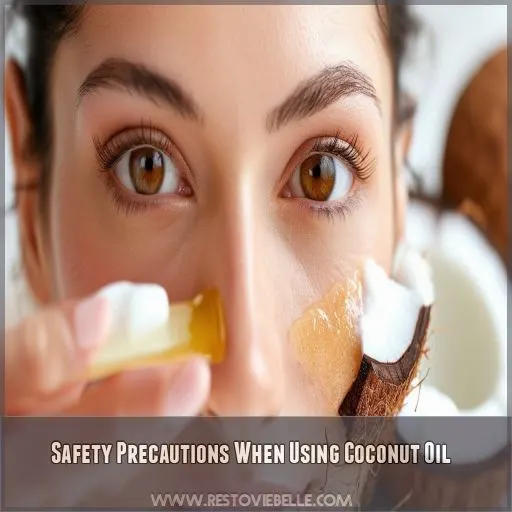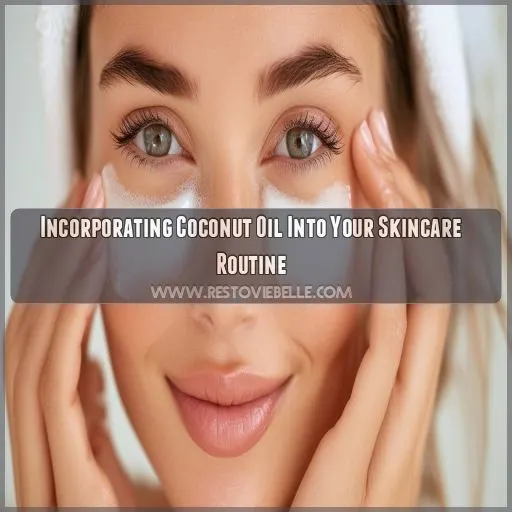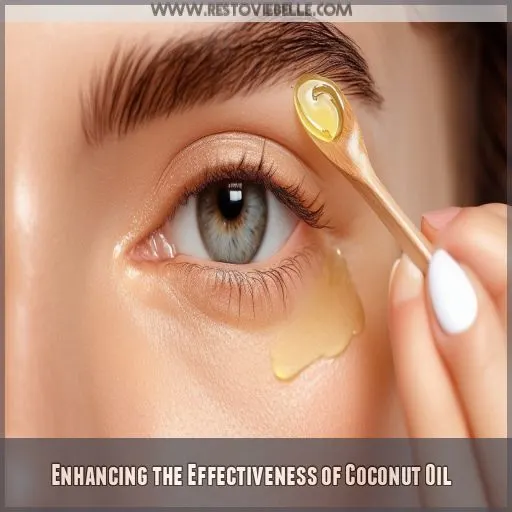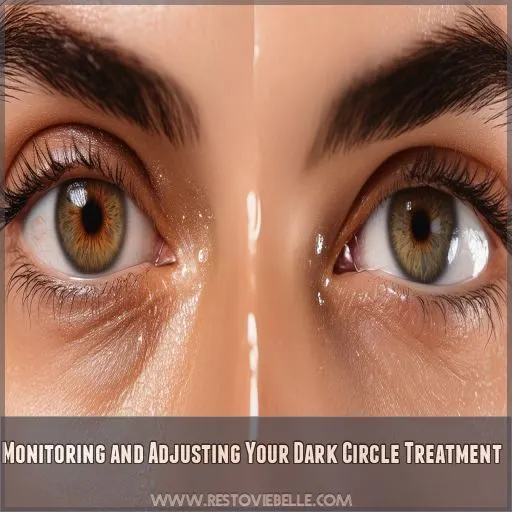This site is supported by our readers. We may earn a commission, at no cost to you, if you purchase through links.
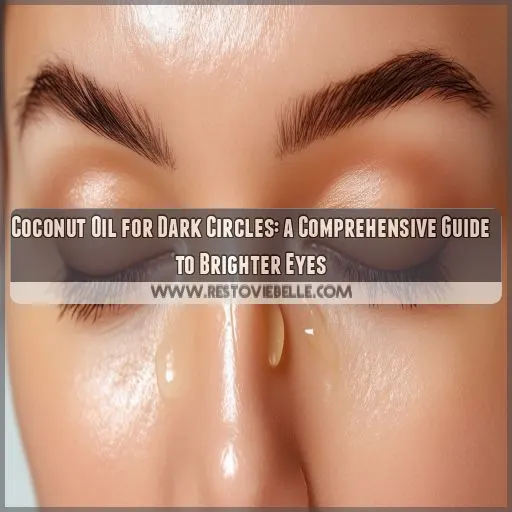 Wake up and face the world with bright, refreshed eyes.
Wake up and face the world with bright, refreshed eyes.
Coconut oil has been touted as a natural remedy for dark circles. Now, it’s time to embark on a journey to test its efficacy.
In this all-inclusive guide, we’ll explore the intricacies of using coconut oil to achieve brighter, more radiant eyes. From application techniques to safety precautions, we will cover everything. So, you can effectively incorporate coconut oil into your skincare routine.
Are you ready to bid farewell to those stubborn dark circles? Let’s delve into the potential benefits of coconut oil for your under-eye area.
Table Of Contents
- Key Takeaways
- How to Use Coconut Oil for Dark Circles Under Eyes?
- How to Apply Coconut Oil for Dark Circles
- Tips for Choosing the Right Coconut Oil
- Alternatives to Coconut Oil for Dark Circles
- Safety Precautions When Using Coconut Oil
- Incorporating Coconut Oil Into Your Skincare Routine
- Enhancing the Effectiveness of Coconut Oil
- Monitoring and Adjusting Your Dark Circle Treatment
- Frequently Asked Questions (FAQs)
- Conclusion
Key Takeaways
- Give Coconut Oil a Try: It’s a natural remedy that can help reduce those pesky dark circles.
- Choose Wisely: Opt for virgin coconut oil for optimal results.
- Be Gentle: Gently massage the oil into your under-eye area to prevent irritation.
- Consistency is Key: Incorporate coconut oil into your nightly routine for the best results.
How to Use Coconut Oil for Dark Circles Under Eyes?
Coconut oil is an effective natural remedy for reducing dark circles under your eyes. To use it, take a pea-sized amount of oil and gently massage it into the affected area using circular and upward motions for 30 seconds. Allow the oil to absorb completely. For best results, do this at night and make it a part of your nightly routine.
It’s important to choose the right type of coconut oil and to perform a patch test to confirm you don’t have any adverse reactions. There are also alternatives to coconut oil that you can explore if you’d like to learn more.
How to Apply Coconut Oil for Dark Circles
Coconut oil is an effective, natural remedy for reducing dark circles.
The application is simple:
- Wash your face and hands.
- Pat a pea-sized amount of coconut oil onto the dark circles.
- Gently massage it into your skin.
Be careful not to rub or get any oil in your eyes. Allow the oil to absorb completely.
For optimal results, incorporate this into your nightly routine and be consistent with its application.
Tips for Choosing the Right Coconut Oil
Selecting the appropriate coconut oil is essential for effectively addressing dark circles. Choose unrefined virgin coconut oil, as it retains more beneficial nutrients, ensuring better absorption and results when applied gently to the skin.
Virgin Coconut Oil
When choosing coconut oil for dark circles, opt for cold-pressed, virgin coconut oil. This type of coconut oil retains its natural healing properties and is rich in skin-strengthening qualities.
Here are some key tips for selecting the right coconut oil:
- Look for "cold-pressed" or "virgin" on the label.
- Choose an organic, unrefined variety to guarantee the highest quality and purity.
- Select a brand that sources coconuts ethically and sustainably.
Massage Technique
For the best results, gently massage a pea-size amount of coconut oil into your under-eye area for at least 30 seconds, using a circular and upward motion. This will help stimulate lymphatic drainage and promote skin health.
Absorption
After massaging, allow the coconut oil to fully absorb. This natural oil has varying absorption times, so be patient.
Here are some tips for choosing the right coconut oil to ensure adequate absorption and skin benefits:
- Opt for virgin coconut oil, which is pure and unrefined, retaining its natural antioxidants and nutrients for better skin absorption.
- Consider the texture and your skin type. If you have oily or acne-prone skin, choose a lighter oil that won’t clog pores, ensuring faster product absorption.
- Patch test different brands to find one that suits your skin, as absorption rates can vary due to individual skin characteristics.
Alternatives to Coconut Oil for Dark Circles
If coconut oil isn’t giving you the results you need, there are many other natural remedies and over-the-counter options to think about for dark circles. Ingredients like cucumber slices, tea bags, and products containing arbutin or retinol can offer additional benefits and may be more effective depending on your skin type.
Other Natural Remedies
If you’re not a fan of coconut oil, there are plenty of other natural remedies you can try to tackle those dark circles. Here’s a table with some alternatives:
| Natural Remedy | Benefits |
|---|---|
| Cucumber slices | Soothing and anti-inflammatory, helping to reduce swelling |
| Tea compresses | Contain antioxidants which may reduce inflammation |
| Tomato paste | Contains lycopene, an antioxidant |
| Potato mask | Contains vitamin C, which may brighten skin |
| Arbutin cream | May correct skin hyperpigmentation |
Over-the-Counter Options
If you’re seeking alternatives to coconut oil for treating dark circles, there are a variety of over-the-counter options available. These include eye creams and serums that are specifically formulated to target dark circles and improve the appearance of the delicate skin around the eyes. When choosing an eye cream, look for ingredients like caffeine, which can help constrict blood vessels and reduce the appearance of dark circles, or retinol, which can stimulate collagen production and thicken the skin. You can also find eye creams that contain antioxidants like vitamin C or E, which can help protect the skin from environmental damage and improve its overall appearance.
In addition to eye creams, there are also medical treatments available, such as laser therapy or injectable fillers, which can help reduce the appearance of dark circles by stimulating collagen production and adding volume to the under-eye area. However, it’s important to consult with a dermatologist or healthcare provider before undergoing any medical treatment to make sure it’s safe and appropriate for you.
Safety Precautions When Using Coconut Oil
While coconut oil is generally safe for topical use, it’s always a good idea to take some precautions to make sure you don’t experience any adverse effects. Here’s what you should keep in mind:
- Allergic Reactions: Although rare, some people may be allergic to coconut oil. To be safe, perform a patch test by applying a small amount of coconut oil to your forearm and waiting 24 hours to see if any irritation or redness occurs.
- Pore Clogging: Coconut oil is rich in fatty acids, which can be beneficial for the skin, but it can also clog pores if you have acne-prone skin. If you’re concerned about breakouts, consider consulting a dermatologist before using coconut oil regularly.
- Skin Sensitivity: If you have sensitive skin, proceed with caution. Coconut oil may cause irritation or redness, so it’s important to introduce it gradually and observe your skin’s reaction.
- Oily Residue: Coconut oil can leave an oily residue, especially if you use too much. Start with a small amount and increase as needed to avoid greasiness.
- Long-Term Effects: There’s limited research on the long-term effects of coconut oil on the delicate skin around the eyes. While it may provide temporary benefits, be mindful that long-term use may have unknown consequences.
- Cell Turnover and Side Effects: Coconut oil is believed to improve cell turnover, but this can also lead to increased skin sensitivity. Pay attention to any side effects, such as dryness, flaking, or irritation, and adjust your usage accordingly.
- Stress Levels and Lifestyle Changes: Remember that dark circles can be influenced by stress levels and lifestyle factors like sleep, hydration, and caffeine intake. Addressing these issues in conjunction with using coconut oil may yield better results.
Incorporating Coconut Oil Into Your Skincare Routine
Coconut oil can be seamlessly incorporated into your skincare routine to target dark circles and promote overall skin health.
The recommended dosage is a pea-sized amount, gently patted into the under-eye area. For best results, consistency is key. Make it a part of your nightly ritual, giving the oil ample time to work its magic while you sleep. With regular use, you may start noticing improvements in as little as a week, including diminished dark circles, reduced puffiness, and softer skin.
Enhancing the Effectiveness of Coconut Oil
To enhance the effectiveness of coconut oil for treating dark circles, consider these strategies:
- Coconut Oil Dosage: Opt for a pea-sized amount for the under-eye area. Start with a small amount and increase as needed.
- Coconut Oil Timing: For best absorption, nighttime application is superior. Apply before bedtime and let it work its magic while you sleep.
- Coconut Oil Combinations: Boost its effects by mixing with other natural ingredients. Try combining with vitamin E oil, known for its skin-healing properties.
- Coconut Oil Masks: For an intensive treatment, use coconut oil eye masks. Soak cotton pads in coconut oil and place them under your eyes for 15-20 minutes.
- Coconut Oil Supplements: Take coconut oil supplements for an internal boost of fatty acids and antioxidants, promoting overall skin health and reducing dark circles from within.
Monitoring and Adjusting Your Dark Circle Treatment
Monitoring your progress and evaluating the effectiveness of your dark circle treatment is essential for achieving your desired results. Here’s a guide to assist you in navigating this process:
- Progress Monitoring: Capture before-and-after photographs to visually compare the changes in your dark circles. This straightforward technique will aid you in noticing subtle improvements that you might otherwise miss, providing a clear indication of whether your treatment is effective.
- Effectiveness Evaluation: Pay close attention to how your skin feels and appears. Are your dark circles visibly diminished? Do you perceive any improvements in skin texture, such as smoother and clearer skin beneath your eyes? Are there any changes in puffiness? By considering these factors, you can gauge the overall efficacy of your treatment regimen.
- Application Modification: If you’re not seeing the desired results, it may be necessary to adjust your application method. Verify that you’re using the appropriate amount of coconut oil and gently massaging it into the skin. Sometimes, a slight alteration in your technique can make all the difference.
- Alternative Approaches: If coconut oil doesn’t provide the expected outcomes, explore other natural remedies or over-the-counter options. Alternatives such as cucumber eye masks, arbutin-based products, or tea bags can offer varying degrees of success, and it’s worth experimenting to find what works best for you.
Frequently Asked Questions (FAQs)
Can I use coconut oil on my eyelids?
Coconut oil is safe to use around the eyes, but it won’t hydrate your eyelids. It’s best to use an eye cream specifically formulated for the eye area. Always consult an eye doctor before putting any substance in or near your eyes.
How long until I see results?
Results may take anywhere from a month to a few months. If you’ve been applying coconut oil for two weeks without seeing any changes, consider consulting your healthcare provider.
What if theres no improvement?
If there’s no improvement after two weeks, consult a doctor, as dark circles can sometimes indicate underlying health issues, such as liver disease.
Are there any side effects?
Coconut oil is generally safe to use, but some people have reported allergies. Other side effects include clogged pores, acne, and breakouts. If coconut oil gets into your eyes, it may cause irritation.
Can I use it with other products?
Coconut oil can be combined with natural ingredients to create DIY treatments for dark circles. For example, you can mix coconut oil with a pinch of turmeric to form a paste. However, there’s limited research on the effectiveness of coconut oil for dark circles compared to other treatments like chemical peels, laser therapy, and specialized under-eye creams.
Conclusion
Dark circles can be a persistent issue, but there is a solution.
By using the appropriate tools and knowledge, you can say goodbye to them for good. In this guide, we will discuss the intricacies of using coconut oil to brighten and revitalize the under-eye area.
You will learn about application methods, selecting the right coconut oil, safety considerations, and more. Now, you can effectively incorporate coconut oil into your skincare routine and enhance the appearance of your eye area.
Remember: consistency and patience are key as you embark on your journey toward brighter, more radiant eyes.

